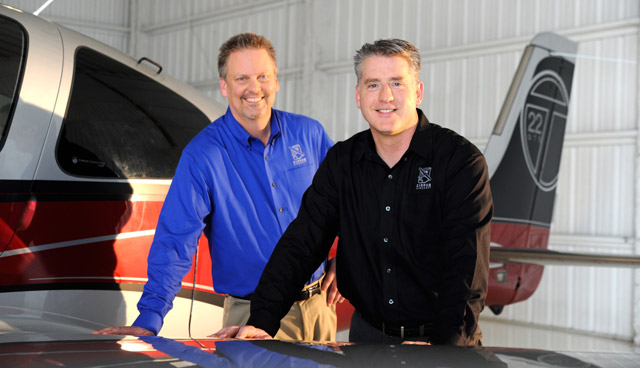Cirrus announces leadership shift, Vision on track
Certification testing to begin within year
 Cirrus Aircraft President Patrick Waddick, right, has assumed that title from founder and CEO Dale Klapmeier, who retains the role of chief executive. Photo courtesy Cirrus Aircraft.
Cirrus Aircraft President Patrick Waddick, right, has assumed that title from founder and CEO Dale Klapmeier, who retains the role of chief executive. Photo courtesy Cirrus Aircraft.
With the fifth generation of its SR22 now on the market, and dozens of new jobs tied to the SF50 Vision Jet being filled, Cirrus Aircraft co-founder and CEO Dale Klapmeier announced March 12 a decision to step back from the day-to-day operations and focus on the company vision, and new products, as chief executive.
Chief Operating Officer Patrick Waddick, who has an engineering background and has been with the company for 25 years, takes over as president (retaining the chief operating officer title), a promotion that puts him in charge of day-to-day operations. The pair gave an exclusive interview to AOPA Online just prior to the official announcement, describing a company on the move with two major new products, and promised more to come.
Cirrus began delivering its fifth-generation SR22 and SR22T models in January, and Waddick said the market has responded with enthusiasm.
“We’ve gotten exceptional feedback in the marketplace from that,” Waddick said, noting the 200-pound increase in gross weight (from 3,400 to 3,600 pounds) has proved particularly appealing. “People appreciate what 200 pounds means.”
The single-engine SF50 jet first flew in 2008, but the program stalled amidst the international economic collapse. The jet program was revived after China Aviation Industry General Aviation Company Ltd. bought Cirrus in 2011. The deal left Cirrus operations and staff in place in Grand Forks, N.D., and Duluth, Minn., while infusing cash—about $100 million going toward development of the personal jet, company officials said in 2012.
Customers—more than 500 deposits of $100,000 each had been collected by April 2012—have waited patiently, and Waddick said progress is visible.
“We have a lot of tooling which is starting to come in,” Waddick said of the jet program, “something we haven’t seen in a while.”
CAIGA shares Cirrus’ objectives to create innovative personal aircraft, he added.
“The jet is an obvious big first place to start,” Waddick said, adding that flight testing for certification is expected to begin within 12 months. “The clock is ticking.”
Klapmeier, who founded the company with his brother, Alan Klapmeier, said handing the day-to-day control over to Waddick leaves him free to focus on customers and future products. Alan has left the company and founded Kestrel Aircraft, located in nearby Superior, Wis.
Dale said CAIGA has primarily been an investor, though “there will come a day when there are some things being manufactured over there.” The company plans to grow its manufacturing base in all locations, he added.
Klapmeier said he discussed the leadership transition—assigning the title and duties of president to Waddick—with the Cirrus board last fall. The timing was aimed at eliminating any distraction that might interfere with bringing the fifth-generation SR22 to market.
Relieved of some of the day-to-day responsibilities, Klapmeier looks forward to spending more time with customers, “being with the customers, seeing how they use our products,” along with “setting the vision and the tone and the direction for the company.”
Klapmeier declined to discuss plans for future products in detail, though he did rule out expansion into transport or unmanned markets. “We are looking to stay true to our heritage of personal transportation.”



